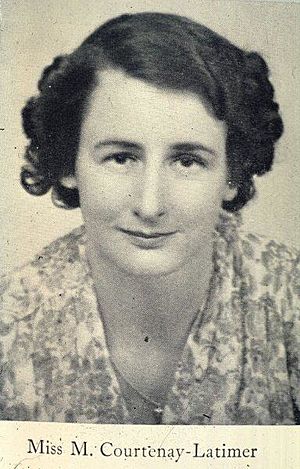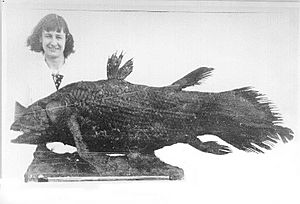Marjorie Courtenay-Latimer facts for kids
Quick facts for kids
Marjorie Courtenay-Latimer
|
|
|---|---|
 |
|
| Born |
Marjorie Eileen Doris Courtenay-Latimer
24 February 1907 |
| Died | 17 May 2004 (aged 97) East London, Eastern Cape, South Africa
|
| Known for | The delivery of the Coelacanth |
| Awards | Honorary doctorate from Rhodes University |
| Scientific career | |
| Fields | Natural history, Palaeontology |
| Institutions | East London Museum |
Marjorie Eileen Doris Courtenay-Latimer (24 February 1907 – 17 May 2004) was a South African museum worker. In 1938, she helped the world discover the coelacanth. This amazing fish was thought to have been extinct for 65 million years!

Contents
Early Life and Dreams
Marjorie Courtenay-Latimer was born in East London, South Africa. Her father worked as a stationmaster for the South African Railways. Marjorie was born two months early and was often sick as a child. She even almost died from a serious infection called diphtheria.
Despite being frail, Marjorie loved nature from a young age. She enjoyed spending time outdoors. When she visited her grandmother by the sea, she was fascinated by the lighthouse on Bird Island. At just eleven years old, she decided she wanted to become an expert on birds.
Starting a Career in Natural History
After finishing school, Marjorie began training to be a nurse in King William's Town. But before she could finish, she heard about a job opening. It was at the new East London Museum in East London, Eastern Cape.
Even though she had no formal training, Marjorie really impressed the people who interviewed her. She knew a lot about South African wildlife and nature. So, at 24 years old, she was hired in August 1931.
Marjorie spent her whole career working at the East London Museum. After retiring, she moved to a farm in Tsitsikamma. There, she wrote a book about flowers. Later, she moved back to East London.
The Amazing Coelacanth Discovery
Marjorie worked hard collecting many items for her museum. She gathered rocks, feathers, and shells. She also let local fishermen know that she was interested in any unusual specimens they might find.
On 22 December 1938, she got a phone call. A very strange fish had been brought in! She rushed to the docks to see the catch of Captain Hendrik Goosen.
Marjorie later described the moment: "I picked away at the layers of slime to reveal the most beautiful fish I had ever seen." She said it was about five feet (150 cm) long and a pale purplish-blue. It had faint white spots and a shiny silver-blue-green colour all over. The fish was covered in hard scales and had four fins that looked like limbs. It also had a strange tail, like a puppy's tail.
She took the fish to her museum in a taxi. She tried to find it in her books but couldn't identify it. Marjorie wanted to preserve the fish, but the museum didn't have the right equipment. She took it to the morgue, but they refused to help her.
She tried to contact her friend, J. L. B. Smith, who taught at Rhodes University. She hoped he could help her identify the fish, but he was away. Marjorie sadly had to send the fish to a taxidermist to be skinned and prepared.
When Professor Smith finally arrived on 16 February 1939, he instantly knew what the fish was. It was a coelacanth! He said, "There was not a shadow of a doubt. It could have been one of those creatures of 200 million years ago come alive again."
Smith named the fish Latimeria chalumnae. He chose this name to honour his friend Marjorie and the Chalumna River, where the fish was found. It would be another fourteen years before anyone found another coelacanth.
Images for kids
-
Brass plate at Latimer's Landing in East London.
See also
 In Spanish: Marjorie Courtenay-Latimer para niños
In Spanish: Marjorie Courtenay-Latimer para niños


